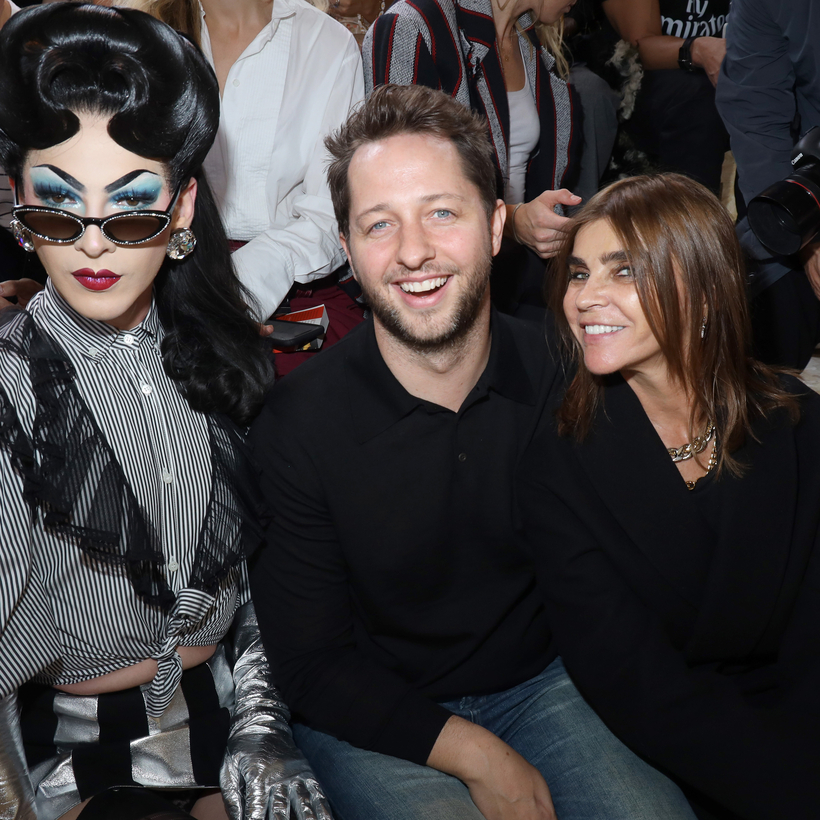The live fashion show—a melding of various skill sets into a brief, intense moment of creative expression—is about 12 minutes long. In addition to the work of the designer, every show requires the efforts of other artistic types—those who create its beauty, look, set, lighting, music.
Yet not all components of fashion-show realization are so obvious. One of the most essential is both arduous and unsung: the task of seating. That grueling, complicated, kinetic art-cum-science-cum-hope-for-the-best is in full swing this weekend at New York Fashion Week.
Warring Egos
From now through the close of the fall 2022 runway season in Paris next month, top P.R. executives and their staffs will toil over how to achieve just the right mix of audience members seated in just the right way to best advance the brand’s goal for the show, while keeping those guests happy.
It isn’t easy. Any long-term professional showgoer has probably witnessed at least one public display of pique by a guest who found his or her seating inadequate. And that’s among those who made the cut.

“You can get these dramatic moments of people’s egos,” says Michael Ariano, publicist to Marc Jacobs, whose shows are always in high demand.
“It’s part of the fun drama of fashion,” says Paris-based Lucien Pagès, whose eponymous communications firm works with brands including Lemaire, Jacquemus, Astier de Villatte, Saint Laurent, Courrèges, and Sacai.
Pagès references complaints he got over seating at “Love Brings Love,” the fashion show honoring the late Alber Elbaz that closed the Paris season in October. While most second-row editors were appropriately respectful (they sat behind, among others, French First Lady Brigitte Macron and mayor of Paris Anne Hidalgo), there were some exceptions, which, Pagès offers, “I’ll keep for my memoirs.”
Years ago, “the shows” were a small, insider event, attended mostly by Western press and retailers, often in showrooms where conditions ranged from cozy to cramped. Next-day U.S. coverage was limited to trade title Women’s Wear Daily (WWD), The New York Times, and a few other daily newspapers and wire services. As for magazines, a monthly was just that—a monthly, covering the collections in print for up to six months after the runway shows.

Beginning in the 90s, three constituencies emerged that cut into the hold the traditional audience held on chair space. World economies had started to change, and what were then known as “emerging markets,” mostly in Asia and the Middle East, began flexing their might globally, while developing an intense interest in Western fashion. Soon, a whole new range of press and retailers commanded prime seating.
About the same time, fashion’s celebrity obsession exploded, its impact registering powerfully on magazine covers and in front rows. While true “friends of the house” had always attended shows—see: Catherine Deneuve at Yves Saint Laurent—enlisting front-row actors and television personalities soon became a major focus across the industry.
Today, it’s widely accepted that boldfaced names often come at a price. Some houses have long-term contractual relationships with “brand ambassadors.” Other houses pay stars a one-time front-row fee. While many brands don’t pay their most well-known, most glamorous, most Instagrammable guests, their expenses—hair, makeup, hotel—are almost always covered.

Over the years, the front-row frenzy has only escalated, helped along by the third new constituency that emerged in the early aughts: bloggers, who begat influencers, who begat the current head-spinning social-media ascendency.
“It’s not just celebrities,” says Rachna Shah, a partner at KCD, whose show clients include Coach, Jason Wu, Prabal Gurung, Rag & Bone, Gucci, and Balmain. “It’s tastemakers, people who wear the brand and are a part of its tribe, people mixing with each other to create photo moments. You could do a story on all of Derek Blasberg’s seatmates and the great photos he takes of them. That brings the brand to life outside of the runway.”
This recalibration has happened over the past several years. While each house works differently, certain trends prevail. For actors, musicians, and influencers, especially those with high engagement and relationships with the brand, front-row seats are guaranteed.
But that has left fewer seats for those of traditional-show lineage. Editors in chief retain their front-row positions, as do top critics and C.E.O.’s of major retailers. The big difference is in the number of seats allotted per title or store. Whereas once a magazine might have commanded three or four front-row seats, and Vogue as many as 10, now those numbers are reduced, and some brands aim for a ceiling of two per title. The remaining editors are sprinkled between the second and third rows.
The logistical and political issues have self-corrected to a degree, because, between budgets and the coronavirus, the teams traveling to shows are now considerably smaller than they were a decade ago. Still, there’s room for bruised egos.
Client Relations
In our angsty world, the topic of show seating skews lighthearted. Yet among the reps for several major European brands whom I contacted (all usual suspects), only Valentino’s chief brand officer, Alessio Vannetti, would discuss it. Perhaps he’s still on a cloud from the house’s recent high-impact product placements. Creative director Pierpaolo Piccioli’s clothes have gotten major screen time—most recently in the much-talked-about finale of And Just Like That…, in which Carrie wears a voluptuous orange taffeta gown to scatter Mr. Big’s ashes in the Seine—followed by major social-media buzz.

The frenzy was triggered by besotted users whom the house now considers “clients,” whether they buy the clothes or not (mostly not). Vannetti explains that C.E.O. Jacopo Venturini has transformed Valentino into “a client- and colleague-centric company and brand,” and that he’s taken a “holistic” view of the concept of “client,” expanding it beyond traditional paying customers to include those who engage via social media. Top influencers in that group forge significant relationships with the house, and they are well seated at its shows.
Which is not to say traditional clients get the cold shoulder. At the recent Valentino couture show, the number of seats was truncated to 68, due to the pandemic. Twelve of them went to clients—the shopping kind.
If “holistic” rings a bit philosophical for the topic of fashion shows, brands are increasingly taking an individual approach as to whom they invite and how they seat them. They want their audiences to reflect the brand ethos.
“There is not one solution that fits everything. You just have to learn what’s important for each house,” says Pierre Rougier, founding partner of PR Consulting, whose client roster includes Gabriela Hearst, Louis Vuitton, Alaïa, and Dries Van Noten.
Rougier and other publicists note a generational difference in the way younger brands approach show invitations. “I find it striking that the younger designers care about a community that they call their own,” populated by people who have supported them from the start, Rougier says. Moreover, some could not “care less about print media or traditional media; they care more about celebrities and influencers.”
Pagès concurs. “Big brands for sure still care a lot about [traditional media]; emerging brands, maybe less. They are quite obsessed with the immediate buzz, but that’s a question of generation.”
The seasoned pros stress to their younger clients the value of both. “They need all the industry leaders on their side to succeed,” Pagès says. “We need true journalism; we need talented fashion stylists. They are the ones that give the ‘stamps of approval.’ They have the fashion culture that the industry will always need.”
Says Rougier, “You don’t need to cater to everyone. But at the same time, you don’t want to alienate people to a point where if you ever need them, they won’t be here for you. It’s really a juggling act.”

Clara Jeon, a founding partner of Chapter 2 Agency, focuses on small brands, including No Sesso, Khiry, and Tombogo, all showing this week. She, too, notes the different mindset of younger designers. “Everything should be representative of the brand’s community,” she says. “Anything facetious and disingenuous is the quickest way for a brand to lose momentum and a loyal fan base, and to lose meaning for the designers themselves.”
Jeon recalls that, a few years ago, Kerby Jean-Raymond put the families of victims of police brutality in the front row at Pyer Moss, and editors in the second row. “That was what was important to him and the brand that season, so that’s what we did.”
Jeon considers emotional comfort when seating guests. She places family and friends near the front of the runway so the designer can easily find them, and she tries to seat reviewers at the end of the runway. This affords the “longest and closest” view of the clothes, and also the speediest way out for them en route to their next show.
Pragmatism drives at least as many decisions as emotion. Jacobs hasn’t participated in New York’s Fashion Week since before the pandemic. Last June, he did a collection exclusive to Bergdorf Goodman. Being off-calendar meant no out-of-town press, while the Bergdorf collaboration limited the essential retailers to one. Ariano says it was thus relatively easy to keep the guest list to an even 100. The company plans a second Bergdorf exclusive this June.
Then there’s camera angle, a consideration that didn’t exist 20 years ago. A savvy seating maestro positions those who have major social reach where they’ll get the best shots. “Now you think about people holding their phones,” says Shah.
It’s a factor driven by a recently emerged and growing segment of the show audience. Those seats had to come from somewhere, including a good number formerly allotted to traditional press. When impacted editors get cranky at the prospect of a row downgrade or no seat at all, these publicists understand. Said one brand executive, who spoke anonymously, “Welcome to the only world that lines you up in order of importance twice a year. It plays on your self-worth. You worry about your job. Of course, people lash out.”
Yet outbursts are rare, and the brands do all they can to facilitate a happy show environment. After years of organizing by category—celebrities, influencers, press, retailers, international attendees by country—Shah now takes more of a dinner-party approach, seating together people she knows like each other or strangers who might hit it off. “There’s other parts to it,” she notes of creating a successful audience experience. “But it’s also the energy of the room.”
Bridget Foley is a longtime fashion journalist who spent more than 20 years as a critic and editor for Women’s Wear Daily


